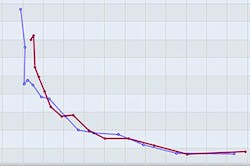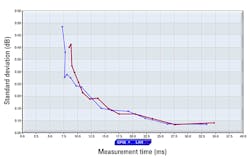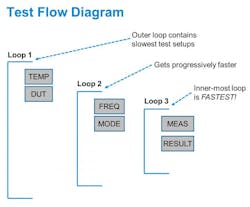Optimize Signal/Spectrum Analyzer Throughput For High-Volume Manufacturing Test
When automating signal analyzers for high-throughput automated testing, there can be tradeoffs between speed, repeatability, and dynamic range. Most modern signal analyzers have built-in functionality and the capability to work as either swept-tuned spectrum analyzers or vector signal analyzers (VSAs). The unique features contained in these instruments allow them to be optimized for one or more operating parameters. For example, they can be optimized for maximum throughput.
Speed, Repeatability, And Dynamic Range
It is difficult to discuss the speed of a particular measurement without also discussing its repeatability. In most cases, tradeoffs can be made to optimize repeatability and measurement time. This can be done by applying averaging to the measurements to minimize variations in the measurement results. Keep in mind that this step adds to the total test time.
Although the relationship between measurement time and repeatability is very intuitive, the relationship between measurement time and dynamic range is sometimes overlooked. A good example occurs when measuring a low-level signal and reducing the resolution bandwidth, which increases sweep time. In some cases, individual measurements are created and then just strung together without looking at the entire test plan. A better approach is to build an entire test plan that accounts for speed, repeatability, and dynamic range—all of which are optimized for maximum throughput.
Creating A Test Plan
The first step is to perform the individual measurements to determine the optimum settings regarding speed, repeatability, and dynamic range. In Figure 1, the repeatability of a fast adjacent-channel-power (ACP) measurement is plotted against the total measurement time and data transfer. The repeatability of the measurement can be improved by increasing the number of acquisitions used in the calculation. Increasing the measurement time will increase the number of acquisitions, thereby improving repeatability.
1. This example of a fast ACP measurement was taken from an X-Series signal analyzer.
To determine the optimum measurement time, choose a time providing the repeatability that gives enough margin to pass a test limit (based upon individual dynamic-range requirements). Having more dynamic range in the measurement will allow for a less repeatable ACP result—and, as a result, a faster measurement while still passing the test limit. This is an example of how speed, repeatability, and dynamic range relate.
Improving the dynamic range can be done with or without a speed penalty. For example, if the designer wants to reduce the analyzer’s noise floor, he or she might first want to reduce the resolution bandwidth. Doing so will increase the sweep time for an overall slower measurement. If possible, reducing the input attenuation or turning on the preamplifier will provide a better noise floor without reducing test time. Some analyzers also have a low-noise path function, which will improve the noise floor with no penalty.
Once the engineer has determined the optimum settings for each individual measurement, it is time to create the entire test plan. First, determine if there are different measurements that can be run in parallel. An example is an error-vector-magnitude (EVM) measurement (which can be started on the signal analyzer) and a power measurement (which can be made simultaneously with a power meter). When the power-meter measurement is completed, the engineer can read the results of the EVM measurement.
2. The nested-loops test flow diagram is depicted here.
In most cases, the test plan will involve multiple nested loops. This is normally required when performing the same test at different parameters for the device under test (DUT). Such parameters may include different input or output levels or device voltages and currents. It is important that faster measurements be placed in the innermost loops while slower measurements are placed in the outer loops. After all, the innermost loops will be run more frequently than the outer loops. Figure 2 is a graphical representation of the nested loops.
Other Test-Time Improvements
Significant test-time improvements also can be made by following some basic rules and practices. In almost all cases, for example, shutting off the display will improve measurement time. The degree of improvement depends upon the amount of time (as a percentage) that the display is updated in the measurement.
Using combined measurements, such as a merged GSM, EDGE, or W-CDMA application, will enable multiple measurements to be made with a single acquisition. This combined measurement application can perform an EVM, output RF spectrum (ORFS), power versus time (PVT), and transmit power measurement and return the results based upon a single acquisition. It is thus significantly faster than performing each measurement individually. If the analyzer has an advanced marker function, the engineer can manually select measurements, such as channel power, ACP, and phase noise (dBc), while maintaining and/or not having to change the current measurement or mode.
The list-sweep mode can be used for making multiple zero-span measurements at different frequencies and quickly returning the results. This can be a good choice for harmonic or third-order-intercept (TOI) measurements, where there are known signals to be measured.
In addition, many spectrum and signal analyzers have built-in input/output (I/O) systems that allow for the use of General-Purpose Interface Bus (GPIB), Gigabit local-area network (LAN), or Universal Serial Bus (USB) as the interface to the instrument. With their high data rates, Gigabit LAN or USB should be used for applications in which large amounts of data is being transferred between the instrument and a computer.
Swept-Tuned Spectrum Analyzers And VSAs
In one instrument, many modern spectrum and signal analyzers function as both swept-tuned spectrum analyzers and VSAs. In most cases, it is much faster to sweep wide spans with a swept-tuned spectrum analyzer than it is to perform Fast-Fourier-Transform (FFT) sweeps. Similarly, it is usually faster to sweep narrow spans in narrow resolution bandwidths utilizing FFT sweeps.
This article only touches the surface of how to optimize the entire production test process. By utilizing some of the features and capabilities that have been discussed, however, an engineer can improve measurement throughput. Doing this before the test code is finalized will save time for both the development of the test system and the entire test plan.
About the Author
Bob Nelson
MXA (N9020A) Product Support Engineer
Bob Nelson is Agilent Technologies’ MXA (N9020A) Product Support Engineer. He has spent the last 14 years with the company, supporting the Agilent field organization and customers with application-focused measurement requirements. Nelson holds a degree in Electrical and Electronic Engineering from California State University, Chico.


